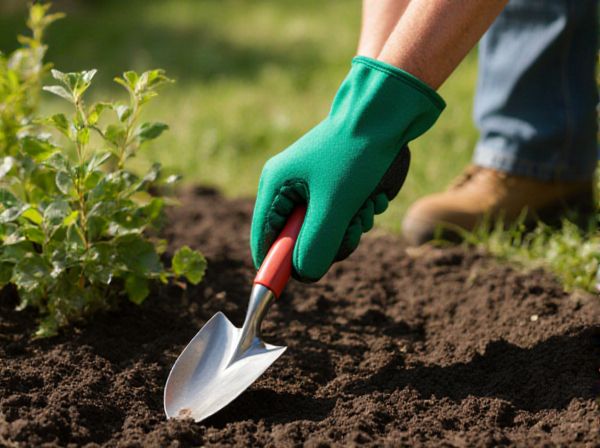
Garden Trowel vs Transplanter Illustration
A garden trowel features a wider, more rounded blade ideal for digging, scooping, and loosening soil, making it perfect for general planting tasks. In contrast, a transplanter has a narrow, elongated blade designed for precision when moving seedlings and small plants without disturbing their roots. Choosing between a garden trowel and a transplanter depends on the specific gardening task and the level of accuracy required.
Table of Comparison
| Feature | Garden Trowel | Transplanter |
|---|---|---|
| Purpose | General digging, planting, and soil mixing | Precision transplanting of seedlings and small plants |
| Blade Shape | Wide, rounded or pointed blade | Narrow, elongated blade with depth measurement markings |
| Blade Length | Approximately 6 inches | Approximately 7-8 inches |
| Handle | Ergonomic, often wooden or plastic | Ergonomic with a firm grip, commonly wood or rubber |
| Use Cases | Digging holes, potting, soil aeration | Transplanting, deep planting, root handling |
| Advantages | Versatile, suitable for various garden tasks | Precise planting, reduces root damage |
| Material | Stainless steel or carbon steel blade | Stainless steel blade with depth indicators |
Garden Trowel vs Transplanter: Key Differences
Garden trowels typically feature a wider, flatter blade ideal for digging, scooping, and mixing soil, while transplanters have a narrower, elongated blade designed for precise root ball removal and transplanting small plants. The garden trowel's broader shape allows for general-purpose gardening tasks, whereas the transplanter's slim profile aids in reaching compact soil spaces without disturbing nearby plants. Both tools boast ergonomic handles but serve distinct functions to optimize efficiency in garden maintenance and plant care.
What Is a Garden Trowel?
A garden trowel is a small hand tool with a pointed, scoop-shaped metal blade designed for digging, planting, and weeding in tight spaces. It features a sturdy handle for easy grip and precise control, making it essential for transplanting seedlings and loosening soil. Compared to a transplanter, a garden trowel offers versatility for various garden tasks beyond just transplanting.
Understanding the Transplanter Tool
The transplanter tool features a narrow, elongated blade designed for precise digging and transplanting seedlings or small plants in tight spaces. Its measurement markings enhance depth control, ensuring accurate placement of roots to promote healthy plant growth. Unlike a garden trowel, which has a wider blade suited for general digging and scooping, the transplanter excels in tasks requiring detailed root management and minimal soil disruption.
Material and Design Comparison
Garden trowels are typically crafted from durable stainless steel or carbon steel, featuring a broader, scoop-shaped blade designed for digging and moving soil efficiently. Transplanters often use similar metal materials but have a narrower, elongated blade that allows precise root placement and easier insertion into tight spaces. Both tools commonly include ergonomic handles made from wood, plastic, or rubber to enhance grip and reduce hand fatigue during extended use.
Best Uses for a Garden Trowel
A garden trowel is best suited for digging small holes, transplanting seedlings, and loosening soil in confined spaces. Its wide, curved blade allows for efficient scooping and mixing of soil, making it ideal for general gardening tasks. Lightweight and versatile, the garden trowel excels in precision work around flower beds and container gardens.
When to Choose a Transplanter
A transplanter is ideal for precise planting and transplanting tasks where narrow, deep holes are required, such as seedlings or bulbs. It features a slender blade that easily penetrates compact soil without disturbing surrounding plants. Choose a transplanter when accuracy and minimal root disturbance are essential for healthy plant growth.
Ergonomics and Comfort Features
Garden trowels feature ergonomically designed handles with cushioned grips to reduce hand fatigue during extended use, making them ideal for general digging and scooping tasks. Transplanters typically have narrower, longer blades and contoured handles that provide precise control and comfort for delicate transplanting work in tight spaces. Both tools prioritize user comfort but differ in blade shape and handle design to optimize performance for their specific gardening functions.
Durability and Maintenance Tips
Garden trowels and transplanters differ significantly in durability, with garden trowels typically made from heavy-duty stainless steel or carbon steel, providing long-lasting resistance to rust and bending. Maintenance tips for both tools include regular cleaning after each use to prevent soil buildup, applying a light coat of oil on metal parts to avoid corrosion, and storing them in a dry environment to prolong their lifespan. Transplanters, often featuring narrower blades, require careful cleaning to maintain sharpness for precise transplanting, while garden trowels benefit from occasional blade sharpening to enhance digging efficiency.
Price and Value for Gardeners
Garden trowels typically cost between $5 and $15, offering affordability and versatility for general digging and planting tasks. Transplanters, ranging from $10 to $25, provide specialized value with narrow, elongated blades ideal for precise seedling and bulb placement. For gardeners seeking cost-effective multi-use tools, trowels offer better price-to-function ratio, while transplanters justify higher prices with enhanced precision in delicate transplanting jobs.
Which Tool is Right for Your Garden?
Garden trowels feature a broader, sturdier blade ideal for digging, planting, and scooping soil, making them versatile for general gardening tasks. Transplanters have a narrower, elongated blade designed to reach deep into soil for relocating seedlings and small plants with precision, minimizing root disturbance. Choosing the right tool depends on your gardening needs: opt for a garden trowel for multi-purpose use or a transplanter for delicate plant relocation.
Garden Trowel vs Transplanter Infographic

 gardendif.com
gardendif.com